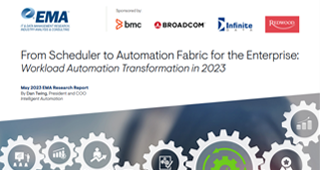As technology continues to evolve, businesses must adapt to the changing landscape to survive. Digital transformation affords these businesses new opportunities to connect with tech-savvy customers and deliver more personalized experiences. In its research report, From Scheduler to Automation Fabric for the Enterprise: Workload Automation Transformation in 2023, EMA says “Companies across all industries are undergoing digital transformation, using technology to optimize processes, improve customer experiences, and drive business growth.” But, how far have businesses progressed in their transformation journey, and what role is automation playing?
The state of digital transformation
Digital transformation has been a hot topic for more than a decade. While companies often see the benefit of adopting new technologies, the majority of organization are still in the early stages of digital transformation. In fact, according to EMA’s report, only 37 percent of companies say their digital transformation journey is underway and only nine percent say they have fully implemented digital transformation or are planning a second phase of digital transformation.
It’s easy to wonder, then, with all the available technology and after more than ten years of hearing the virtues of digital transformation extolled, why haven’t companies embraced digital transformation?
The answer is simple: digital transformation isn’t easy. Because of innovations in areas such as cloud and data technologies, and constantly evolving best practices like DataOps and DevOps, companies have the opportunity to continually improve their business. However, this creates an ever-moving target. The speed at which a company can enact digital transformation can be determined by internal factors such as company size, company goals, technology infrastructure, and level of employee preparedness. Often, companies may have made progress in some areas of digital transformation, such as automation, but still have a long journey ahead of them in other areas.
The role of automation in digital transformation
Automation plays an integral role in supporting digital transformation. Workload automation (WLA) is particularly important. Too often, WLA is written off as simply batch scheduling. However, the role of automation has expanded to enterprise-scale workflow orchestration. With that in mind, it’s clear that WLA and digital transformation are inextricably linked. According to the EMA report, “Today, WLA plays a key role in both developing and operating digitally transformed processes.”
Organizations that take full advantage of modern workflow orchestration platforms will see the most digital transformation success. The further into their digital transformation journey a company gets, the more they require from their WLA solution. According to EMA’s report, 81 percent of companies agree that digital transformation requires more from automation solutions. Additionally, they explain, “Companies who are mature with digital transformation are more likely to test limits of their WLA solution.” With the complexity of digital operations continuing to grow, organizations must constantly find new ways to use automation to align automated processes with their business objectives.
Application and data workflow orchestration is a team sport
Clearly, digital transformation will die on the vine without the proliferation of automation and application and data workflow orchestration, and not just in IT. Non-IT users across the business can also leverage self-service automation and workflow orchestration to perform vital functions within their jobs. Automation has become so enmeshed in the day-to-day performance of departments across the enterprise that non-IT users are taking a vested interest in continuing its expansion and improvement. In fact, according to EMA, 85 percent of companies say that developers led the charge sponsoring new automation and orchestration initiatives among non-IT users. Other teams that commonly use self-service workflow orchestration capabilities include DevOps teams, data engineers and DataOps teams, cloud architects, sales teams, service teams, supply chain teams, finance teams, HR, and many more.
If you’re ready to start your digital transformation journey, application and data workflow orchestration platforms like Control-M (self-hosted and SaaS) are invaluable. With Control-M you can easily build, define, schedule, manage, and monitor production workflows, and integrate, automate, and orchestrate them on-premises or in the cloud to make your digital transformation a reality.







